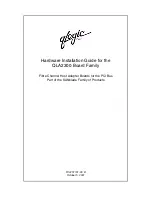
Linksys Voice System Administration Guide
135
SIP-NAT Interoperation
SIP-NAT Interoperation
If the SPA9000 is behind the NAT device, the private IP address of the SPA9000 is not usable for
communications with the SIP entities outside the private network.
Note
If the ITSP offers an outbound NAT-Aware proxy, this discovers the
public IP address from the remote endpoint and eliminates the need to
modify the SIP message from the UAC.
The SPA9000 system must substitute the private IP address information with the proper
external IP address/port in the mapping chosen by the underlying NAT to communicate with a
Table A-1 Architectural Components
Architectural Component
Function
SIP proxy and Registrar server
Accepts registration from client stations and
proxies SIP messages.
Media proxy server
Proxies RTP packets between client stations
and proxies SIP messages.
Configuration server
Serves configuration files to client stations
and auto configures un-provisioned client
stations.
Application server
Supports advanced features such as call
park/pickup, directory, directed call pickup
and group paging, hunt groups, and shared
line appearances.
Internal music source
Streams audio files to client stations (both
on-net and off-net).
The FXS1 and FXS2 can optionally be
connected to an external music source to act
as a streaming audio server (SAS). When
working in this mode, each FXS port can
handle up to 10 concurrent calls.
Administration web server
Allows configuration and monitoring of the
SPA9000.
ATA with 2 FXS ports
Each FXS port can be connected to analog
phones, fax machine, or an external music
source. Each port can support up to two calls
simultaneously. The FXS ports can only
register to the internal proxy server.
Call park
The call park is used to maintain calls that are
parked and can handle up to 10 calls
simultaneously
Auto-Attendant
AA is a scriptable auto-attendant application
that can handle up to 10 calls simultaneously
















































